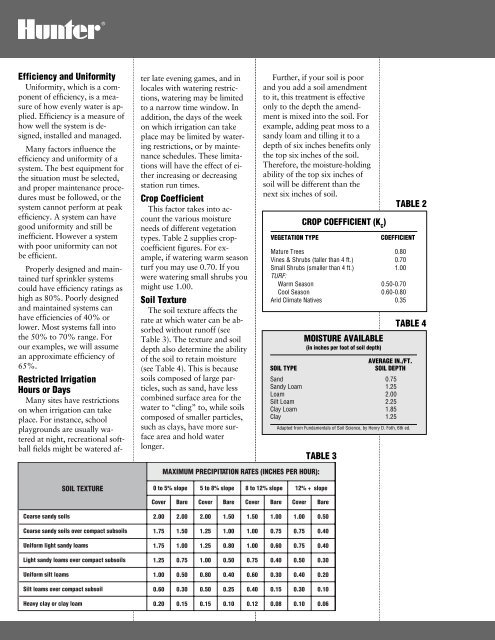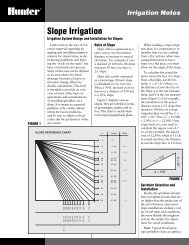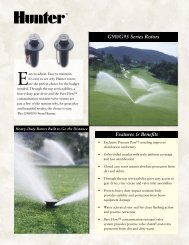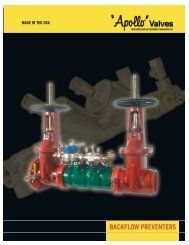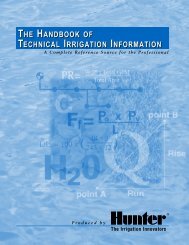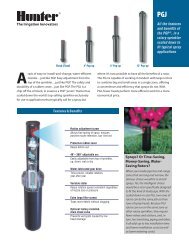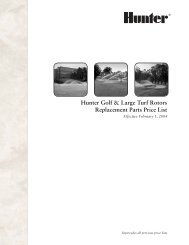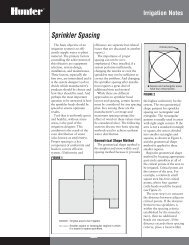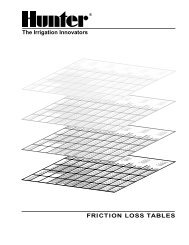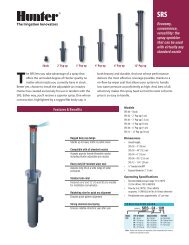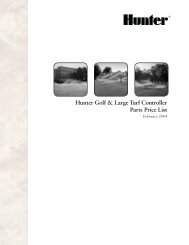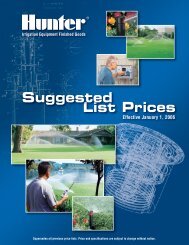LIT-088 Irrigation Notes: Scheduling Irrigation - Hunter Industries
LIT-088 Irrigation Notes: Scheduling Irrigation - Hunter Industries
LIT-088 Irrigation Notes: Scheduling Irrigation - Hunter Industries
You also want an ePaper? Increase the reach of your titles
YUMPU automatically turns print PDFs into web optimized ePapers that Google loves.
Efficiency and UniformityUniformity, which is a componentof efficiency, is a measureof how evenly water is applied.Efficiency is a measure ofhow well the system is designed,installed and managed.Many factors influence theefficiency and uniformity of asystem. The best equipment forthe situation must be selected,and proper maintenance proceduresmust be followed, or thesystem cannot perform at peakefficiency. A system can havegood uniformity and still beinefficient. However a systemwith poor uniformity can notbe efficient.Properly designed and maintainedturf sprinkler systemscould have efficiency ratings ashigh as 80%. Poorly designedand maintained systems canhave efficiencies of 40% orlower. Most systems fall intothe 50% to 70% range. Forour examples, we will assumean approximate efficiency of65%.Restricted <strong>Irrigation</strong>Hours or DaysMany sites have restrictionson when irrigation can takeplace. For instance, schoolplaygrounds are usually wateredat night, recreational softballfields might be watered af-ter late evening games, and inlocales with watering restrictions,watering may be limitedto a narrow time window. Inaddition, the days of the weekon which irrigation can takeplace may be limited by wateringrestrictions, or by maintenanceschedules. These limitationswill have the effect of eitherincreasing or decreasingstation run times.Crop CoefficientThis factor takes into accountthe various moistureneeds of different vegetationtypes. Table 2 supplies cropcoefficientfigures. For example,if watering warm seasonturf you may use 0.70. If youwere watering small shrubs youmight use 1.00.Soil TextureThe soil texture affects therate at which water can be absorbedwithout runoff (seeTable 3). The texture and soildepth also determine the abilityof the soil to retain moisture(see Table 4). This is becausesoils composed of large particles,such as sand, have lesscombined surface area for thewater to “cling” to, while soilscomposed of smaller particles,such as clays, have more surfacearea and hold waterlonger.Further, if your soil is poorand you add a soil amendmentto it, this treatment is effectiveonly to the depth the amendmentis mixed into the soil. Forexample, adding peat moss to asandy loam and tilling it to adepth of six inches benefits onlythe top six inches of the soil.Therefore, the moisture-holdingability of the top six inches ofsoil will be different than thenext six inches of soil.VEGETATION TYPECROP COEFFICIENT (K C)TABLE 3TABLE 2COEFFICIENTMature Trees 0.80Vines & Shrubs (taller than 4 ft.) 0.70Small Shrubs (smaller than 4 ft.) 1.00TURF:Warm Season 0.50-0.70Cool Season 0.60-0.80Arid Climate Natives 0.35MOISTURE AVAILABLE(in inches per foot of soil depth)AVERAGE IN./FT.SOIL TYPESOIL DEPTHSand 0.75Sandy Loam 1.25Loam 2.00Silt Loam 2.25Clay Loam 1.85Clay 1.25Adapted from Fundamentals of Soil Science, by Henry D. Foth, 6th ed.TABLE 4MAXIMUM PRECIPITATION RATES (INCHES PER HOUR):SOIL TEXTURE0 to 5% slope 5 to 8% slope 8 to 12% slope 12% + slopeCoverBareCoverBareCoverBareCoverBareCoarse sandy soils2.002.002.001.501.501.001.000.50Coarse sandy soils over compact subsoils1.751.501.251.001.000.750.750.40Uniform light sandy loams1.751.001.250.801.000.600.750.40Light sandy loams over compact subsoils1.250.751.000.500.750.400.500.30Uniform silt loams1.000.500.800.400.600.300.400.20Silt loams over compact subsoil0.600.300.500.250.400.150.300.10Heavy clay or clay loam0.200.150.150.100.120.080.100.06


